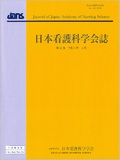Japanese
English
- 販売していません
- Abstract 文献概要
- 参考文献 Reference
要旨
目的:地域包括ケア病棟の看護師が実践する退院支援のプロセスを明らかにし,効果的な看護実践への示唆を得る.
方法:地域包括ケア病棟勤務経験2年以上,看護師経験5年以上の看護師19名を対象に半構造化面接を実施し,修正版グラウンデッド・セオリー・アプローチの手法で分析した.
結果:退院支援のプロセスは,患者の入院・転棟の決定時から,《60日退院の軌道乗せ》と〈退院後のイメージ化〉を開始し,これら2つを往還しながら,同時にプロセスの核となる【地域で生きる力の回復・補強】に向けて患者と家族に働きかけるものであり,〈患者の生き方を慮る〉,〈家族と緊密に連絡〉,《専門職チームの一丸化》が,プロセス全体を円滑に進める推進力となっていた.
結論:本研究結果を現場で適用する際には,高齢入院患者の特徴を十分に踏まえたうえで,退院支援プロセスの核である【地域で生きる力の回復・補強】が促進されるよう,各々の支援を円滑に実施することが重要である.
Objective: To clarify community-based integrated care ward nurses' process of providing discharge support as a basis for discussing effective nursing practice.
Methods: Semi-structured interviews were conducted with 19 nurses who had worked as a nurse for 5 years or longer and as a community-based integrated care ward nurse for 2 years or longer. The interview data were analyzed, adopting the Modified Grounded Theory Approach.
Results: The ward nurses' process of providing discharge support was summarized as follows: They initiated 2 approaches for patients, «planning for patients to be discharged within 60 days after admission» and <visualizing each patient's life after discharge>, as soon as hospitalization/transfer to another ward was determined. While continuing these approaches, they made commitments to both patients and families, with the aim of [recovery, and regaining the ability to lead a community life], which was the core element of this process. Other approaches, such as <considering each patient's way of living>, <closely contacting families>, and «acting as a united professional team», helped the entire process smoothly proceed.
Conclusions: When providing discharge support based on the results of this study, it may be important to sufficiently consider the characteristics of elderly inpatients, and then smoothly implement each approach toward [recovery, and regaining the ability to lead a community life] as the core element of this process.
Copyright © 2021, Japan Academy of Nursing Science. All rights reserved.


